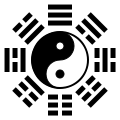Jing (Chinese: 精; pinyin: jīng; Wade–Giles: ching1) is the Chinese word for "essence", specifically Kidney essence. Along with qi and shen, it is considered one of the Three Treasures of traditional Chinese medicine.
YouTube Encyclopedic
-
1/3Views:23 1643 84632 638
-
Shen: The Spirit Force in Traditional Chinese Medicine
-
Concept of "Jing" in Traditional Chinese Medicine - Part 1 by Dr. Colton Oswald, Calgary
-
The Fundamentals of Traditional Chinese Medicine: Three Treasures, Four Levels, Five Elements
Transcription
Description
According to Traditional Chinese Medical theory, jing or essence can be summarised in two parts: the Yin, being congenital or prenatal, and the Yang, being postnatal or acquired. Prenatal jing is acquired at birth from the parents: the father's sperm and the mother's ovum. Postnatal jing is acquired after birth through food, water, oxygen, as well as environmental and social conditions. The concept is expounded in the Chinese theoretical cosmological treatise called the Bagua and within the I Ching.[citation needed]
The Yin and Yang jing transform to create and replenish each other. The Yang jing circulates through the eight extraordinary vessels and transforms to become and replenish yin; in turn the marrow becomes blood, body fluid and semen.[1]
Jing should not be confused with the related concept of jin (勁; "strength" or "energy"), as in as in Neijin meaning "internal power", nor with jīng (經; "classic"), which appears in many early Chinese book titles, such as the Huangdi Neijing, Yijing, and Chajing.[2]
The characteristics which constitute signs of good jing (e.g. facial structure, teeth, hair, strength of adrenals or Kidneys) share the embryological origin of neural crest cells.[citation needed] These cells undergo immense and challenging cellular migrations requiring great organization. As such, jing may simply represent the strength of embryological self-organization in the organism.[citation needed] This will be manifested most strongly in those cells which require most organization; that is, the neural crest cells.[3]
Allocation
One is said to be born with a fixed amount of jing (prenatal jing is sometimes called yuanqi) and also can acquire jing from food and various forms of stimulation (exercise, study, meditation).
Theoretically, jing is consumed continuously in life; by everyday stress, illness, substance abuse, sexual intemperance, etc.
Prenatal jing is very difficult to be renewed, and it is said it is completely consumed upon dying.
Restoration
Jing is therefore considered quite important for longevity in traditional Chinese medicine (TCM); many disciplines related to qigong are devoted to the replenishment of "lost" jing by restoration of the post-natal jing and transformation of shen. In particular, the internal martial arts tai chi, the Circle Walking of Baguazhang and the middle path of Wuxingheqidao may be used to preserve pre-natal jing and build post-natal jing, if performed correctly.[citation needed] In Traditional Chinese herbal medicine Ginseng is widely used to bolster and support the jing or Essence.[4]
An early mention of the term in this sense is in a 4th-century BCE chapter called Neiye "Inner Training" of a larger text compiled during the Han dynasty, the Guanzi.[5]
See also
- Traditional Chinese Medicine
- Dantian
- TCM model of the body
- Triple burner
- Yuan qi
- Shen
- Glossary of alternative medicine
References
- ^ Maciocia, Giovanni (1989). "ch. 3: The Vital Substances". The Foundations of Chinese Medicine. Churchill Livingstone. ISBN 0-443-03980-1.
- ^ Unschuld, Paul (2003). Huang Di Nei Jing Su Wen: Nature, Knowledge, Imagery in an Ancient Chinese Medical Text. University of California Press. p. 17. ISBN 0-520-23322-0.
- ^ Keown, Daniel (2014). "Jing: The Ten Thousand". The Spark In The Machine. Jessica Kingsley. ISBN 9781848191969.
- ^ Shengmai San. Taylor & Francis. 2002. ISBN 9780203216453.
- ^ Graham, A.C. (1993). Disputers of the Tao: Philosophical Argument in Ancient China. Open Court. pp. 100. ISBN 0-8126-9087-7.
Further references
- Chang, Stephen T. The Great Tao; Tao Longevity; ISBN 0-942196-01-5 Stephen T. Chang
- Kaptchuck, Ted J., The Web That Has No Weaver; Congdon & Weed; ISBN 978-0-8092-2933-8
- Maciocia, Giovanni, The Foundations of Chinese Medicine: A Comprehensive Text for Acupuncturists and Herbalists; Churchill Livingstone; ISBN 0-443-03980-1
- Ni, Mao-Shing, The Yellow Emperor's Classic of Medicine : A New Translation of the Neijing Suwen with Commentary; Shambhala, 1995; ISBN 1-57062-080-6
- Holland, Alex Voices of Qi: An Introductory Guide to Traditional Chinese Medicine; North Atlantic Books, 2000; ISBN 1-55643-326-3
- Unschuld, Paul U., Medicine in China: A History of Ideas; University of California Press, 1985; ISBN 0-520-05023-1
- Graham, A.C. Disputers of the Tao: Philosophical Argument in Ancient China (Open Court, 1993). ISBN 0-8126-9087-7
- Scheid, Volker, Chinese Medicine in Contemporary China: Plurality and Synthesis; Duke University Press, 2002; ISBN 0-8223-2857-7
- Porkert, Manfred The Theoretical Foundations of Chinese Medicine MIT Press, 1974 ISBN 0-262-16058-7
- Hongyi, L., Hua, T., Jiming, H., Lianxin, C., Nai, L., Weiya, X., Wentao, M. (2003) Perivascular Space: Possible anatomical substrate for the meridian. Journal of Complementary and Alternative Medicine. 9:6 (2003) pp851–859
- Wang, Mu. Foundations of Internal Alchemy: The Taoist Practice of Neidan. Golden Elixir Press, 2011. ISBN 978-0-9843082-5-5.
- Wile, Douglas Lost T'ai-chi Classics from the late Ch'ing Dynasty (1996) State University of New York Press, Albany. ISBN 0-7914-2653-X

